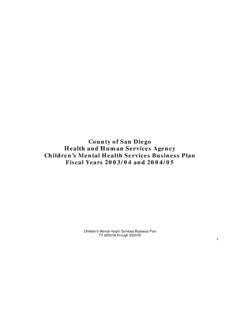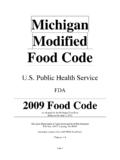Transcription of Retail Food Facility Operator's Guide - San Diego …
1 Retail food Facility . Operator's Guide . County of San Diego Department of Environmental Health food & Housing Division Box 129261. San Diego , CA 92112-9261. (619) 338-2379 (619) 338-2245 fax County of San Diego Department of Environmental Health The San Diego County Department of Environmental Health food and Housing Division seeks to increase life expectancy and the quality of life by promoting public health and safety for the million residents of San Diego County and the more than million overnight guests that visit the County each year. Our commitment is embedded in our goals and objectives and includes providing the greatest opportunity for reducing health disparities community wide regardless of age, gender, ethnicity, income, education, geographic location, disability, or sexual orientation.
2 One of the food and Housing Division's main goals is to reduce the number of foodborne illnesses caused by key pathogens in San Diego County. We plan on working toward this goal by focusing our efforts on risk factors that can lead to foodborne illness in Retail food facilities within San Diego County and by working to improve food employee behaviors and food preparation practices that directly relate to foodborne illness in Retail food establishments. There are 18 cities with more than 10,000 Retail food establishments in San Diego County. The types of food facilities regulated by San Diego County include: restaurants, Retail food processors, markets, wholesale food warehouses, boats (with food service), school kitchens, food carts and lunch trucks, and Retail markets.
3 This Guide has been developed to provide operators with a basic understanding of the principles of public health and the operation of our food Inspection Program. The use of this Guide will assist operators in determining the current status of their operation and provide the tools necessary to improve all aspects of food handling, preparation, storage, transportation and service. In addition, this Guide provides operators with information regarding the inspection process, the report issued by the Registered Environmental Health Specialist, and the scoring criteria for the grading system. Table of Contents Page Number County of San Diego food & Housing Division 1. food Safety Risk Factors for foodborne illness 2.
4 Understanding The food Facility Inspection Report 2. food 3. Temperature Control 4-5. Personnel 6-7. Water & Sewage 8. Equipment 9. Proper Washing & Sanitizing 10-11. Floors, Walls & Ceilings 11. Toilet Room & Hand Lavatories 12. Light & Ventilation 12. Pest Control 12. Refuse 12. Operations 13. Policies Closure 13. Official Notice 13. Plan Check 13. Understanding Your Grade and Grade Posting 14. Requirements Important Contacts 15. Wastewater Discharge Contacts for food Facilities 16. Appendices APPENDIX A: Self Inspection Checklist A1-2. APPENDIX B: food Facility foodborne illness Report B1. APPENDIX C: Major foodborne illness Pathogens C1-3. APPENDIX D: Proper Cooking & Holding Temperatures D1.
5 APPENDIX E: Thermometer Calibration E1. APPENDIX F: food Transportation & Delivery Guidelines F1. APPENDIX G: Grease Traps/Interceptors in food Facilities G1. APPENDIX H: Catering/ food Delivery Vehicles H1-2. APPENDIX I: Temporary Events I1. APPENDIX J: Procedures for food Facilities in the Event of a J1-2. Major Disaster or Emergency Water Outage Safety Guidelines for food Facilities J3. APPENDIX K: Guidelines for food Safety & Security K1-2. APPENDIX L: Hazard Analysis Critical Control Point (HACCP) L1. APPENDIX M: To Go or Leftovers Label M1. APPENDIX N: Raw Gulf Oyster Requirements N1-4. APPENDIX O: Recall Procedures O1. County of San Diego Department of Environmental Health food & Housing Division Qualifications of Environmental Health Specialists Environmental Health Specialists (EHS) are required to have a Bachelor's degree from an accredited college or university with at least 30 semester units of basic biological, physical, or environmental science courses.
6 All Environmental Health Specialists in the food & Housing Division are required to possess a valid registration as a Registered Environmental Health Specialist in the State of California. This registration ensures that Environmental Health Specialists have met specific educational, training, and experience requirements to better serve their communities. What to do in the event of a foodborne illness food Facility operators are encouraged to report all foodborne illness complaints to the Department of Environmental Health, foodborne illness complaint number at (619) 338-2356. Once the report is taken, the Epidemiology Liaison will determine if a site visit is necessary.
7 Any information received from a complainant regarding a foodborne illness is kept confidential. See Appendix B for a foodborne illness self-reporting form. Interested in becoming more involved in San Diego food Safety? The food Safety Advisory Counsel (FSAC) includes members of industry, consumer groups, The Health & Human Services Agency, academia and the food & Housing Division. The FSAC meets on a quarterly basis to discuss important food safety issues in San Diego County. If you are interested in getting involved in the food Safety Advisory Counsel, please contact us at (619) 338-2360. Building or Remodeling Your food Facility ? A person proposing to build or remodel a food Facility shall submit complete, easily readable plans, drawn to scale, and specifications to the local enforcement agency for review and approval before starting any new construction or remodeling of any Facility for use as a Retail food Facility .
8 The plans shall be approved or rejected within 20 working days after receipt by the local enforcement agency and the applicant shall be notified of the decision. For more information about plan submission, contact the Plan Check Unit at (619) 338-2364. food & Housing Division Contact Numbers Environmental Health Specialist on Duty (619) 338-2379. Complaints (619) 338-2283. foodborne illness Complaints (619) 338-2356. Foodhandler Training Information (619) 338-2484. Plan Check Unit (619) 338-2364. Website: E-mail: San Diego Office San Marcos Office El Cajon Office 1255 Imperial Ave., 3rd Fl. 338 Via Vera Cruz, Rm. 201 200 E. Main, 6th Fl. San Diego , CA 92101 San Marcos, CA 92069 El Cajon, CA 92020.
9 (619) 338-2222 (760) 471-0730 (619) 441-4030. M-F 8am 5 pm M-F 8am 4 pm M-F 8am 4 pm 1. food Safety Risk Factors For foodborne illness According to the Centers for Disease Control and Prevention (CDC), five food safety risk factors related to employee behaviors and preparation practices have been identified as contributing to foodborne illness . They are: 1. Improper holding temperatures 2. Poor personal hygiene 3. Inadequate cooking 4. Contaminated equipment 5. food from an unsafe source The Environmental Health Specialist focuses on the above critical risk factors when conducting a routine inspection. By focusing on the 5 major risk factors for foodborne illness , the Environmental Health Specialist can help food Facility operators identify areas that may increase the risk of foodborne illness .
10 Once these areas are identified, the Environmental Health Specialist can discuss methods for reducing/improving the unsafe conditions. Focusing on the major risk factors also emphasizes the most important areas for food Facility operators to continuously monitor. Understanding The food Facility Inspection Report The Environmental Health Specialist will use the official inspection report when grading your Facility . The point values of violations noted are weighted on the food safety risk factors mentioned above. At the completion of the inspection the Environmental Health Specialist will review the results of the inspection and the necessary actions required to correct any violations.




